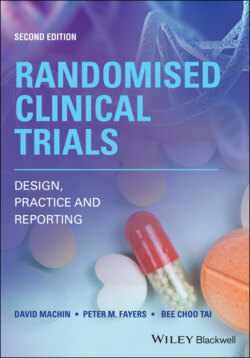Читать книгу Randomised Clinical Trials - David Machin - Страница 60
2.9 Analysis and reporting
ОглавлениеThe main purpose of the statistical analysis at the end of the trial will be on comparing the two intervention groups with respect to the endpoints specified in the protocol at the design stage. This comparison will involve estimating the difference between groups, the associated confidence interval and p‐value. The statistical methods to be used will depend on the type of endpoint variable concerned. However, this basic analysis may need to take into account specific features of the design, such as whether a stratified or cluster randomisation was used. It may also be appropriate to allow for patient or disease characteristics which may influence outcome in an important way. Further, there may be secondary outcomes to summarise, although these may or may not involve formal statistical comparisons, and there may be unanticipated features such as serious adverse events (SAE) or unusual toxicities that were not anticipated at the protocol design stage. We describe some details of how the analysis of a trial is carried out in Chapter 8.
In addition, it is important to document patient progress through the different trial stages by, for example, tracking the number consenting to participate, the number randomised, those completing therapy and the number in which the endpoint assessment has been made in each intervention group. The CONSORT statement described by Moher, Hopewell, Schultz, et al. (2010) provides a framework for this. We referred to this in Figure 1.3, and we will expand upon on the details in Chapter 11.
It is also usual to provide in tabular form and by allocated intervention group, some basic demographic details, often a minimum of age and gender, together with some pertinent clinical information, perhaps stage of the disease and a summary of clinical and/or diagnostic test results.
